Related Research Articles

Gothic fiction, sometimes called Gothic horror in the 20th century, is a genre of literature and film that covers horror, death and at times romance. It is said to derive from the English author Horace Walpole's 1764 novel The Castle of Otranto, later subtitled "A Gothic Story". Early contributors included Clara Reeve, Ann Radcliffe, William Thomas Beckford and Matthew Lewis. It tends to stress emotion and a pleasurable terror that expands the Romantic literature of the time. The common "pleasures" were the sublime, which indescribably "takes us beyond ourselves." Such extreme Romanticism was popular throughout Europe, especially among English and German-language authors. Its 19th-century success peaked with Mary Shelley's Frankenstein and work by E. T. A. Hoffmann, Edgar Allan Poe and Charles Dickens, and in poetry with Samuel Taylor Coleridge. Also prominent was the later Dracula by Bram Stoker and Strange Case of Dr Jekyll and Mr Hyde by Robert Louis Stevenson. The name Gothic spread from the Goths to mean "German". It also draws in Gothic architecture of the European Middle Ages, where many of the stories occur. Twentieth-century contributors include Daphne du Maurier, Stephen King, Shirley Jackson, Anne Rice and Toni Morrison.

Wuthering Heights is an 1847 novel by Emily Brontë, initially published under the pseudonym Ellis Bell. It concerns two families of the landed gentry living on the West Yorkshire moors, the Earnshaws and the Lintons, and their turbulent relationships with Earnshaw's adopted son, Heathcliff. The novel was influenced by Romanticism and Gothic fiction.

The Winter's Tale is a play by William Shakespeare originally published in the First Folio of 1623. Although it was grouped among the comedies, many modern editors have relabelled the play as one of Shakespeare's late romances. Some critics consider it to be one of Shakespeare's "problem plays" because the first three acts are filled with intense psychological drama, while the last two acts are comic and supply a happy ending.
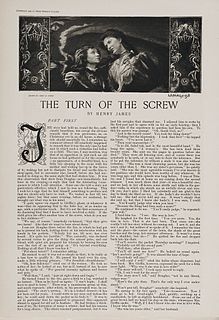
The Turn of the Screw is an 1898 horror novella by Henry James which first appeared in serial format in Collier's Weekly. In October 1898, it was collected in The Two Magics, published by Macmillan in New York City and Heinemann in London. The novella follows a governess who, caring for two children at a remote estate, becomes convinced that the grounds are haunted. The Turn of the Screw is considered a work of both Gothic and horror fiction.
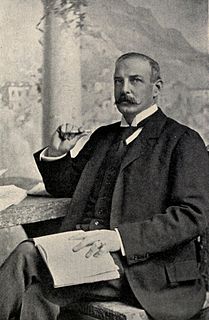
Francis Marion Crawford was an American writer noted for his many novels, especially those set in Italy, and for his classic weird and fantastic stories.
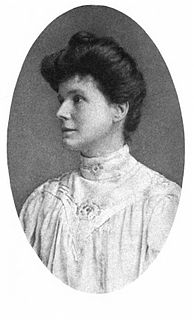
May Sinclair was the pseudonym of Mary Amelia St. Clair, a popular British writer who wrote about two dozen novels, short stories and poetry. She was an active suffragist, and member of the Woman Writers' Suffrage League. She once dressed up as a demure, rebel Jane Austen for a suffrage fundraising event. Sinclair was also a significant critic in the area of modernist poetry and prose, and she is attributed with first using the term 'stream of consciousness' in a literary context, when reviewing the first volumes of Dorothy Richardson's novel sequence Pilgrimage (1915–1967), in The Egoist, April 1918.
Perdita, may refer to:

The Woman in Black is a 1983 gothic horror novel written by Susan Hill. The plot concerns a mysterious spectre that haunts a small English town. A television film based on the story, also called The Woman in Black, was produced in 1989, with a screenplay by Nigel Kneale. In 2012, an eponymous film adaption was released, starring Daniel Radcliffe.
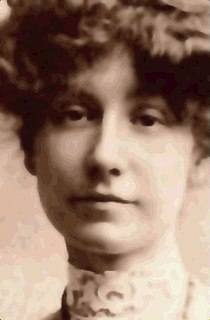
Margaret Gabrielle Vere Long, who used the pseudonym Marjorie Bowen, was a British author who wrote historical romances, supernatural horror stories, popular history and biography.
The Legend of the Mistletoe Bough is a horror story which has been associated with many mansions and stately homes in England.
"Morella" is a short story in the Gothic horror genre by 19th-century American author and critic Edgar Allan Poe.
Cecil William Turpie Gray was a Scottish music critic, author and composer.
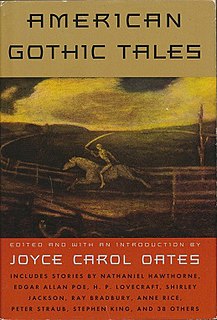
American Gothic Tales is an anthology of "gothic" American short fiction. Edited and with an Introduction by Joyce Carol Oates, it was published by Plume in 1996. It featured contributions by Washington Irving, Nathaniel Hawthorne, Edgar Allan Poe, Stephen King, Anne Rice and others, and included over 40 stories.
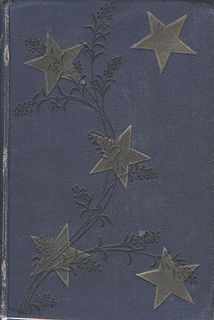
"Olalla" is a short story by the Scottish novelist, poet, essayist and travel writer Robert Louis Stevenson. It was first published in the Christmas 1885 issue of The Court and Society Review, then re-published in 1887 as part of the collection The Merry Men and Other Tales and Fables. It is set in Spain during the Peninsular War.
American gothic fiction is a subgenre of gothic fiction. Elements specific to American Gothic include: rationality versus the irrational, puritanism, guilt, the uncanny, ab-humans, ghosts, and monsters.
Axelle Carolyn is a Belgian filmmaker and former actress and journalist.
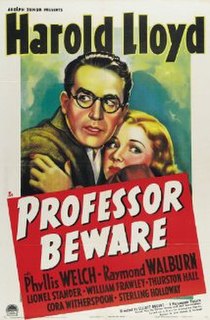
Professor Beware is a 1938 comedy film starring Harold Lloyd and directed by Elliott Nugent. It was Phyllis Welch MacDonald's first and only film.
The Winter's Tale is a ballet in three acts choreographed by Christopher Wheeldon to a commissioned score by Joby Talbot. The ballet is based on the play of the same name by William Shakespeare. With scenery and costumes designed by Bob Crowley, lighting designed by Natasha Katz, and special stage effects designed by Daniel Brodie and Basil Twist, it was a co-production of the Royal Ballet and the National Ballet of Canada. It was first presented at the Royal Opera House, London, on 10 April 2014. The North American premiere occurred the following year.
The Poor Clare is a short story by English Victorian writer Elizabeth Gaskell. First serialised in three installments in 1856 Charles Dickens' popular magazine Household Words, The Poor Clare is a gothic ghost story about a young woman unwittingly cursed by her own grandmother.

The Haunting of Bly Manor is an American drama-gothic romance streaming television series created by Mike Flanagan, and released on October 9, 2020 by Netflix. It mostly acts as an adaptation of the 1898 novella The Turn of the Screw by Henry James, but also includes other elements either based on James' other works or created for the show; it is also the second entry in Flanagan's The Haunting anthology series, acting as a follow-up to 2018's The Haunting of Hill House. It features much of Hill House's crew and some of the same cast, but the two series' narratives are not connected.
References
- ↑ Breznican, Anthony (August 24, 2020). "Viewer Beware: Here's Your First Look at The Haunting of Bly Manor". Vanity Fair. Retrieved October 15, 2020.
- AMERICAN GOTHIC TALES by Joyce Carol Oates (New York,The Penguin Group 1996) ISBN 0-452-27489-3
- AMERICAN GOTHIC FICTION: AN INTRODUCTION by Alan Lloyd-Smith (New York, The Continuum International Publishing Group 2004) ISBN 0-8264-1594-6